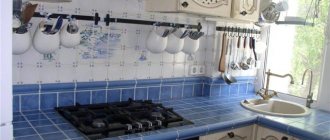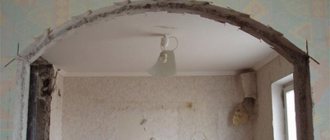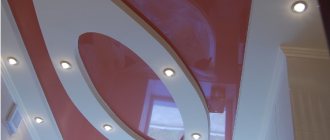What is the level for?
If anyone doesn’t know, a level is a synonym for a laser level. The material is specifically about a laser level, since there are also optical devices. The tool itself is designed to implement the following tasks:
- Alignment of walls
- Laying tiles and tiles on walls and floors
- Installation of windows and interior doors
- Hang a picture, shelf or furniture on the wall evenly
- Align wall-mounted outlets and switches
The use of a laser level is quite wide, and it is in demand not only among builders and craftsmen. If you plan to renovate a house or apartment, then without such a tool it will be difficult to cover the walls with plasterboard or plaster them evenly. In scientific terms, a level is a device that detects and records the exact location of different objects in height. The main task is to measure the difference in height between the marks of the future structure.
Many experienced builders do not understand why a laser level is needed until they try the tool in action. After all, an alternative option for leveling surfaces, which is used not only by home craftsmen, but also by experienced specialists, is a water level. However, such a tool has large errors and also requires a lot of time to cut a plane on the surface. The level does not have such disadvantages, so it is simply necessary for those who build, repair, lay tiles and lay communications.
This is interesting! The disadvantage of levels is their high cost; only such financial costs are paid off very quickly, for example, by high-quality and fast repairs or construction of a house.
The principle of operation of an optical level during shooting
Let's consider the process of class IV leveling using the so-called “middle thread” method. First of all, the device is brought into working condition using a contact or cylindrical level. Then the telescope is pointed at the surface of the black side of the rear rail and the level bubble is brought to the mentioned “zero point” (using lifting or elevator screws). Now the rangefinder and middle strokes allow you to take a reading. Then, in the same way, we shoot by pointing the telescope at the surface of the black side of the front staff, then at the surface of the red side of the front of the staff, and finally along the surface of the black side of the rear of the staff. In case of use optical level with a compensator, the first thing to do is to install the device in the working position and check the normal operating condition of the compensator. And only then can you start filming. During the filming process, all observations must be recorded in a field journal. It’s even more convenient to use the recorder’s storage device for these purposes. If a difference in excess values of more than 5 mm is detected, repeated measurements are necessary, and in this case it is necessary to change the height of the device by at least 3 cm. When completing field work, it is necessary to calculate the discrepancy along the line between the original benchmarks. Its value should not be higher than 20 mm. The results of field work are entered into a special record of excesses. Today there is no alternative to using an optical level, so in the coming decades this tool will be absolutely indispensable when carrying out geodetic work.
Video: Levels Setl, Vega. Beginning of work
Where to start using the tool - preparation for work
The accuracy of the device's readings depends on its correct installation. The level must be leveled by placing it in a vertical position, and only after that can you begin leveling. To level the device, its design includes a special tripod, presented in the form of a tripod. Each leg of the tripod has the ability to be adjusted - it is implemented through sliding sliders, so there are no difficulties with leveling the laser level.
This is interesting! Expensive models of laser levels have a built-in option for self-leveling or self-adjustment. This is achieved due to the fact that the device is fixed at one point, and with deviations of up to 5 degrees, self-leveling is performed. For this purpose, the instrument mechanism is equipped with a geroscope.
You can make sure that the device is installed correctly by looking for air bubbles in the water flask. These are similar flasks that are used in water levels to detect deviations from a flat plane. Once the device is installed, you can begin to use it. If you use an expensive laser level equipped with a self-leveling option, then the instructions for setting it up are slightly different:
- Level the device using a tripod
- Turn it on and wait until additional adjustment or adjustment occurs, which ensures high accuracy of readings
- When self-leveling, the level emits corresponding signals (flashing or beeping), and as soon as they stop, the device is ready for use
- If the level cannot perform the self-adjustment option for a long time, this means that the deviation angle is more than 5 degrees, and it is necessary to make more precise adjustments to the tripod
If measurements are carried out in an open area and the device is installed on the ground, then the legs of the tripod should be firmly fixed in the ground. To do this, each leg has special protrusions for digging them in. The device is connected to the tripod using a special threaded connection. If the diameters of the threaded connections on the instrument body and the tripod are different, then you need to use an adapter.
Features of rotary models
These are the most technologically advanced devices designed for marking on a construction site. The key feature of such models is the presence of a rotating detector, which contains two lasers. They can move at speeds of about 600 rpm, projecting a beam over a 360° range. How to work with a rotary type level? The technique for handling such devices generally corresponds to standard laser devices, and the difference lies only in the organization of the final markings. That is, if the beam in conventional models provides information about one characteristic, after which it needs to be moved, then the rotary technique allows complex calculations to be carried out from one position. This approach is especially effective when installing windows, performing surface finishing, and in other operations where it is necessary to obtain data about the position of different objects within the same room or construction site. But in open areas, restrictions may arise related to the range of the target object.
Checking the device for correct installation
Much depends on the accuracy of the measurement results carried out by the device. If the plane for laying tiles is knocked off, then the evenness of the installation of the tool will affect the interior design. If the plane is checked during the construction of a house, then the installation of the level will affect the quality of construction and the reliability of this structure.
Each device (depending on the model and its cost) has corresponding error indicators. The permissible error values are indicated directly in the instructions for the equipment, which should be taken into account when purchasing a tool. Acceptable error values are indicated in the appropriate units of measurement, which are mm/m. Errors are not so important when using the device indoors, but they are extremely necessary when carrying out external work on beating a plane and leveling walls.
The error is one of the main technical parameters of the instrument, and some manufacturers indicate the magnitude of deviations not only in the technical documentation, but also on the body of the device. If the magnitude of the error is known, then the permissible deviation from the norm can be calculated. If the deviation value is higher than permissible, it is recommended to use a level with a smaller error value.
It doesn't matter if the laser level is being used to level a floor, wall or ceiling, but before taking the corresponding measurements, you will need to check the accuracy. The check is quite simple, for which the following steps are performed:
- First you need to put marks on two parallel walls in the room, according to which the check will be carried out
- One mark is placed on the wall that is closer to the device (at a distance of up to 1 meter)
- The second mark is placed on the opposite wall, located at a distance of more than 2 meters. The further the distance between the walls, the more accurately device deviations can be identified
- After marking with a marker or pencil on the wall, you need to move the level directly to the wall, which was further from the level
- Align the directional laser beam with the point that was marked. Then project the beam onto the opposite side and see if it matches the mark
- If it matches, then the instrument has an insignificant error (note that the greater the distance between the walls, the higher the error, and the smaller the gap between them, the correspondingly lower the error)
- If the laser beam does not coincide with the mark, then there is an error, and its magnitude is quite high. There are special adjustment screws in the device body, which also allow you to adjust the level, reducing deviations from the norm
Before using a laser level to level walls, you need to make sure that there are no large deviations, otherwise the indicators will not correspond to reality. Below is a video instruction and training on how to properly check the level for measurement accuracy.
What will you need for the job?
A tripod should be used to ensure the correct position of the device. You can do without it in a room with a flat base, but if it comes to working on a construction site on bare ground, then adjustable equipment will not be superfluous. But even indoors without special load-bearing devices will be inconvenient to work with the device. For such purposes, ergonomic holders are provided. They can be attached to walls, floor coverings and even to the ceiling.
A special rail will also be required. Its scale will allow you to mark divisions on the target surface, along which the required readings will be recorded. How to work with a level and staff? Traditional methods assume that two people will be involved in the process - one is directly responsible for recording the data, and the second holds the staff. However, the latest models of laser electronic devices automatically process the data, taking into account special bar codes of the strips. In this case, the user only needs to activate the corresponding function and set the scale position correctly.
How to use a laser level, learning how to work
If you manage to install and check the accuracy of the tool, then using it to level the surface of the walls will not be difficult. How to operate this device correctly is indicated in the instructions. However, few people read the instructions, and refer to them only after discrepancies arise. Working with a laser level should be carried out in a calm environment, since this device is the foundation for subsequent actions. If possible, ask someone with experience to advise you, or better yet, show you how to use a laser level correctly. If this is not possible, then training is carried out independently.
Before using a laser level, you need to know that there are devices that have different functions. Almost all models are capable of building not only horizontal, but also vertical planes. There is also an option such as constructing two parallel vertical planes, however, the more additional functions, the more expensive the tool itself. In addition to the built-in options, additional devices will help expand the functionality and simplify the use of the tool, which are also useful to know about.
This is interesting! When using a laser level, it will be useful to know that the device has three modes - vertical and horizontal plane construction, as well as a plumb line. A plumb line allows you to project points in two directions - onto the floor and ceiling, which is very convenient when you have to build a partition.
How to work with a laser type level?
The device is also fixed using a tripod or special holders. After making sure that the installation is secure, you can begin work activities. After pressing a special button, a beam is sent to the target surface. Lines can be projected horizontally or vertically, and some models also provide the possibility of cross-radiation. After this, the device automatically takes readings from the prepared staff with divisions. If you plan to mark over long distances, then you cannot do without a special receiver that will separately record the position of the beam. How to learn to work with a level supplemented with such a device? Basic operations are also taken over by automation. The operator only needs to monitor the readings on the display of the receiver, which can record the position of points at distances of the order of 80-100 m. At the moment the beam is registered, the device will give an appropriate signal and display the received information on the screen, which is recorded in the log.
Auxiliary options for laser levels
Levels are classified into two types: household and professional. Professional ones are also called construction ones, since they are mainly used in construction, electrical installation and geodesy. When carrying out repair work, household laser levels are used, which differ from their professional counterparts not only in price, but also in additional capabilities. As a rule, household levels have a primitive set of functions that allows them to satisfy the needs of the master when carrying out interior finishing repairs. To expand the functionality of the tool, additional equipment is used:
- A laser beam receiver is a special device that allows you to increase the range of the beam (increase its visibility over long distances). This equipment is very convenient when there is a need to use it outdoors. The receiver allows you to observe the projection of the beam not only over long distances, but also in sunlight. The receiver allows you to double the beam distance. When choosing such equipment, you need to take into account that they work clearly in conjunction with only one manufacturer, for example, Bosch. You also need to know that not all models of laser levels can work with receivers. If this is not possible, then you can increase the beam range using a reflective plate
- The target is another additional accessory that comes with many level models. The target is a plate on which markings are applied. Using such an auxiliary device, you can set the accuracy of measurements. An example of using a target is quite simple - instead of an inconspicuous point on the wall, you need to hang this plate, which is much easier and easier to navigate, especially when the distance is 20-30 meters
- The optical sight is another accessory that allows you to track the range of the beam even at a distance of up to 100 meters
- Rail - used in cases where several parallel lines must be drawn on the surface of a wall or other object, while maintaining the same distance. The staff also measures the height of the level attached to the tripod.
All these auxiliary devices make it easier to manipulate the operating device. Professional models of devices have the option of rotating the laser at an angle of 360 degrees. Such devices are especially valuable, since with their help you can make a projection not only on one wall, but throughout the entire room, which simplifies marking work. When all the nuances are known, it is necessary to move on to direct training in using laser levels.
Laser level device
Models of this kind do not include a telescope, which saves the user from independently determining the geometric parameters of the object. The working basis is a laser emitter that projects a beam onto the target area. The design also provides for the presence of control fittings, but in this case the margin of error is eliminated, since most models, regardless of position, can automatically adjust the beam direction angle relative to the horizontal.
How does a laser level work? The device prepared for the operation is oriented with optics towards the object, as a result of which a point is reflected on the surface, by which the height can be estimated and measurements can be taken. Such equipment is good because it reduces the risk of error due to the human factor. Its advantages also include a wide range of additional options related to the processing of received information.
Instructions for use when laying tiles and tiles
When laying tiles on a wall, a laser level is used to ensure that the tiles are positioned strictly at right angles. This depends on the interior design of the room. When laying tiles, the device must be switched to the cross-plane construction mode. At the same time, the level builds two planes - horizontal and vertical, which allows you to immediately install the tiles at a right angle.
Work can be carried out in two ways: with the level turned on, which directs projection rays onto the wall, and also by marking with a mark or pencil. Points are marked along the projection planes of the laser beam with a marker or pencil, and then the tiles are laid on their basis. In a similar way, you can lay tiles not only on the wall, but also on the floor. After turning on the device, it must be aligned parallel to the wall. The center of the cross should be aligned with the seams of the tiles, and the sides of the tiles should be aligned along the guide lines created by the rays.
Types of levels
Currently, you can find various types of levels on sale, which differ in their characteristics. Depending on the accuracy of such devices, they are usually divided into three categories:
- Technical, the error of which can reach 10 millimeters.
- Accurate - with an error of no more than 2 millimeters.
- Highly accurate - with a permissible error of 0.5 millimeters.
Until the recent past, optical levels were in demand, but today the most popular are measuring instruments that are built on electronic and laser technology.
Laser levels are compact in size, and using such a device does not require any professional skills. Today, such devices are most popular in construction, where they can be used to calculate the horizontality of even small-sized surfaces. Laser models are capable of drawing a luminous, clear line, the presence of which makes it possible to visually establish existing deviations from the horizontal, which greatly simplifies the necessary calculations.
Optical instruments use a special design of numerous lenses, which allows you to build the most accurate image, obtaining data on the horizontal surface. This measuring device is simple in design and easy to use. It consists of the following elements:
- Telescope.
- Stands.
- Round level.
- Tripod or tripod.
How to use a laser level when wallpapering
The tool is also useful when gluing wallpaper, when it is very difficult to focus on the evenness of the vertical line. In order for each subsequent sheet of wallpaper to be positioned evenly, it is necessary to turn on the laser level in the vertical plane projection mode. You can use this line as a guide when gluing wallpaper. If the wallpaper is glued in a horizontal direction, for example, then the horizontal projection mode is activated.
Using this useful measuring tool, you can check the quality of the work performed by the contractor. To do this, you need to turn on the tool and project the beam onto the wall. Deviations and unevenness in the arrangement of wallpaper sheets will be visible along the reference line. Based on such a check, you can achieve a reduction in the cost of services for the work performed or even come to the conclusion that the wallpaper will be re-glued, but at the expense of the contractor.
This is interesting! When using the device, you must set it to zero. What does this term mean? Set the level to zero - this means the distance from the ground to the beam that the instrument projects. Setting the zero makes it easier to find the beam, especially when work is carried out outdoors over long distances. If, for example, the level zero point is 1 meter, and after 20 meters measurements show that the projection is at a level of 1.2 meters or 0.8 meters, then there are ground unevennesses. These deviations may be of smaller significance, which are almost impossible to visually identify.
Optical level device
There are four main elements of the device
1. Optical device, the so-called telescope. The operating principle of this part is free rotation in a horizontal plane. The main function of the telescope is to point the system at the subject.
2. Cylindrical level. This part is an extremely sensitive device. Its purpose is to determine the accuracy of the level's orientation relative to the plumb line. The accuracy of the location of the horizontal axis is determined by the location of the level bubble at the so-called “zero point”.
3. Tribrach. Stand for telescope with three screws that adjust the height of the location.4. Elevation screw. This detail is responsible for unambiguous orientation. To determine the parameter, it is necessary to bring the sighting line of the device to a horizontal position. In addition, a compensator is built into the design of the latest models of optical levels in most cases. Its task is to maintain the instrument in a strictly horizontal position and, as a result, eliminate errors that can be caused by even a slight tilt of the device, while geodetic surveying becomes more accurate. The choice of the type of optical level is based on the required measurement accuracy depending on the level of work carried out by the surveyor .
How to use when installing furniture
This device is also used for leveling furniture in a room. Moreover, this applies not only to hanging furniture - cabinets, shelves, etc., but also to those located on the floor. If you need to hang a cabinet or shelf on the wall, then using a regular water level is extremely inconvenient. By turning on the level and setting the cross projection mode, you can safely hang a shelf or cabinet on the wall in your home. High accuracy and evenness of furniture arrangement plays an important role in interior design.
How to use a level to level a sofa, bed, refrigerator or electric stove. Kitchen cabinets also require a straight line arrangement, and an indispensable level will also help in this matter. Of course, you can take a water level, since its error is acceptable, but with an optical device it will be much easier to cope with the task.
The meter is switched to the mode of constructing a horizontal plane, and then the furniture is configured. To do this, there are adjusting screws on the furniture legs, with which you can achieve a straight position.
Design and classification of standard levels
Schemes for the arrangement of axes during level verification: A - c - diagrams for the arrangement of axes during level verification, d - positions of the level during the third verification.
Level sensors must be built into the upper part of the design of all levels. Accurate installation of the device on the ground determines the quality of further measurements. A qualified specialist will regularly check the values of these sensors, adjusting them if necessary using special tilt levers of the optical-mechanical unit. You can promptly detect a random deviation of the device from the exact location on the ground and not take measurements again.
Before using the level and the bar, you will need to familiarize yourself with the main types of devices for geometric measurements of excess height.
A meter with automatic compensation for installation errors is more accurate, but it costs much more. It is convenient to use when taking measurements on problematic soils: crushed stone, sand, etc. Devices with an electronic measurement system are used in the design of large-scale objects. This design is difficult to set up and operate.
According to the class of measurement accuracy, leveling structures can be divided into the following main groups:
- technical devices (marking N-10, N-12, etc.);
- precision devices (designations from N-3 to N-9);
- ultra-precise devices (designations from N-05 to N-2.5).
The numbers in the marking indicate the average measurement error in mm/km. It should be understood that even a technical device will give a deviation of about 1 cm per 1 km of distance to the object. This is enough to carry out accurate design and proper planning of a large number of construction works.
How to use a level when building a foundation
If the principle of operation of the device is clear, then there will be no problems with projecting the surface for leveling. If a foundation is being built, then with the help of a level you can project a vertical line along which you can focus on the evenness of its pouring. It should be taken into account that it is necessary to focus on the vertical before constructing the frame on which the foundation is poured. If the frame is built according to the guideline, then the foundation will be poured correctly and evenly.
If the foundation has already been poured, then the sequence of actions will be as follows (vertical evenness is determined):
- First, the device is leveled, and it should be located in the center of the structure
- At the next step, you need to take a flat stick - a strip on which marks will be applied
- We measure the first corner of the finished foundation by making a notch on the strip used for marking. If the projected line is not visible, then the receiver should be used to identify the projected line
- Measure each corner of the constructed foundation in a similar way, making sure it is straight.
- Deviations in the evenness of the foundation should not be more than 3-5 cm. Discrepancies up to 2-3 cm are acceptable
If earlier simple tools such as a tape measure, ruler and water level were used to level planes, today a laser level can easily replace them. It allows you to simplify and speed up the work on projecting planes. The high cost of this device does not allow a complete transition to the use of such high-precision devices, and therefore they are used by construction teams who can afford to use equipment of this type. The estimated cost of the level in question is about 10-20 thousand rubles. This is a device that can be used to take measurements indoors and outdoors. There are cheaper and more expensive models, so when choosing them you need to understand for what purpose you plan to use them.
As a result, it should be noted that working with a laser level is not difficult, unlike outdated optical devices that are still used in geodesy. However, companies carrying out geodetic measurements are gradually switching from outdated devices to laser levels, which have become very popular in construction, geodesy and other areas where reliability and efficiency depend on accuracy and straightness.
Operation of optical instruments
As already mentioned, work begins with setting up the telescope. The main task at this stage is to achieve extreme clarity of the image of the object. Adjustment is made using screws, and correctness is assessed by looking through the eyepiece.
Further work, unlike laser models, is carried out by two people. One worker sets the staff perpendicular to the ground, and the second takes readings using the image of an optical level. How to work with it so that the correctness of the data does not decrease during the operation? Firstly, much will depend on the reliability of the position of the device. Therefore, special attention is initially paid to the stability of fixation of the legs. Secondly, professional surveyors use spirit levels. These are devices with bubble levels, thanks to which both the position of the tripod and the position of the level are adjusted. When the device is ready for use, the pipe sight is aimed at the divisions of the staff. Then all that remains is to record the readings in the technical journal.











